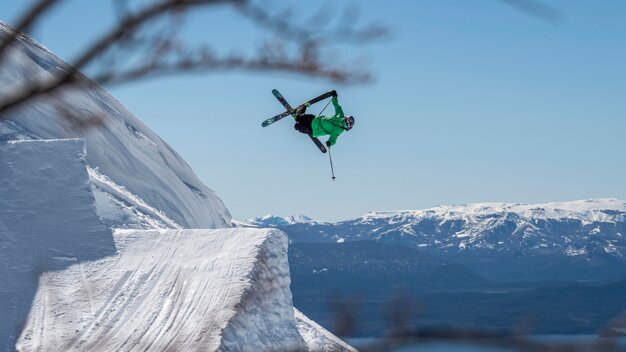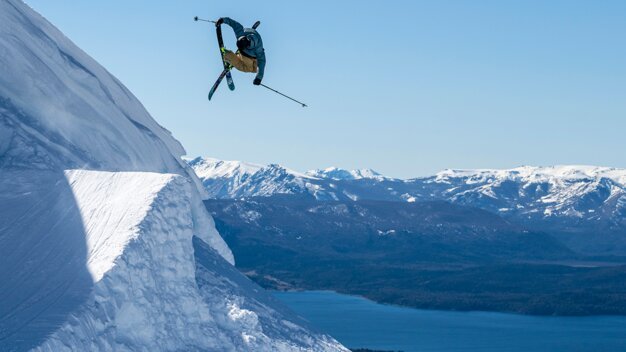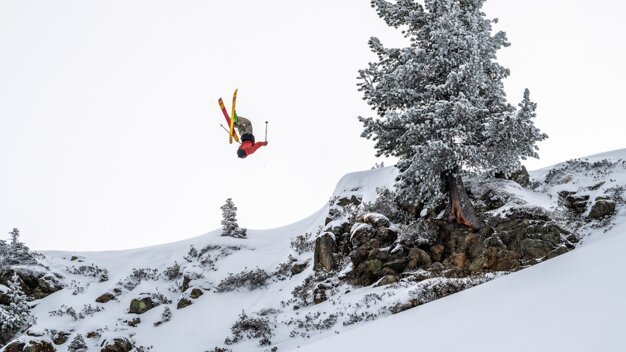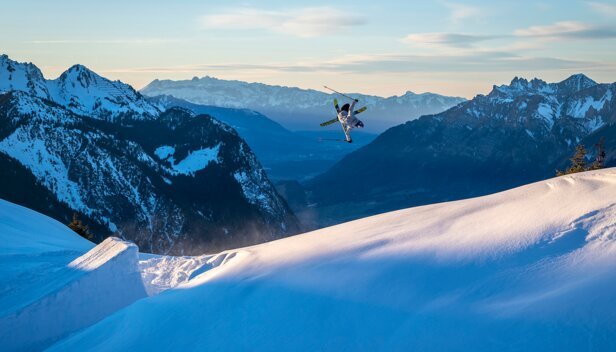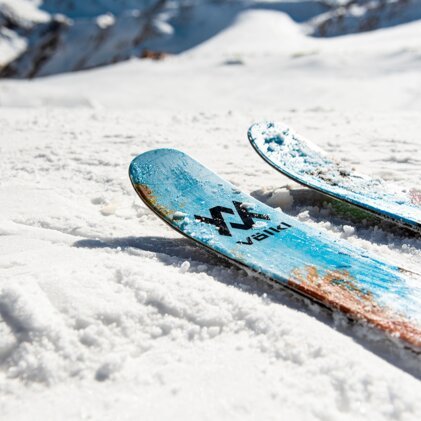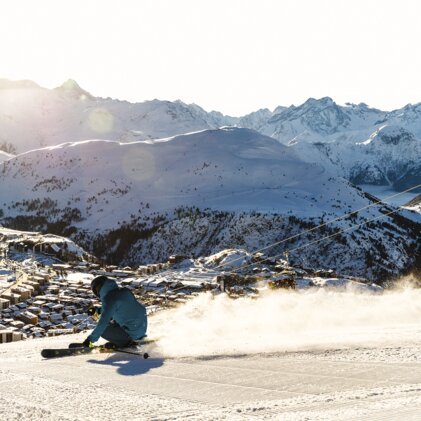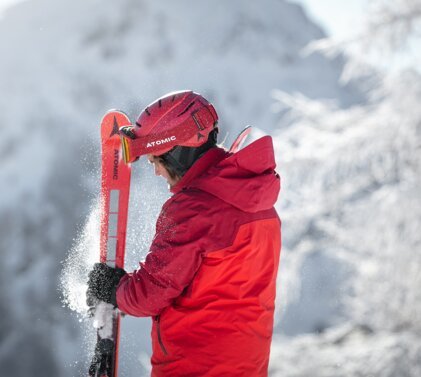
Want to show off your skills in the snowpark soon, but don't have the right freestyle bindings yet? No problem! Our experts at INTERSPORT Rent will tell you all about the special features of ski bindings, what to look for when buying them and what other accessories you will need. Read our tips and get the bindings that suit you best! Have fun jibbing!
What are freestyle bindings?
Freestyle bindings are special models that have been optimised for the demands of the park. They are built to be more robust and solid than alpine ski bindings to withstand the more intense stresses of jumps, tricks and hard landings in the snowpark. They have a high release resistance (high Z-value) to prevent accidental release under high pressure. They are usually designed to provide good flexibility to cushion impacts. Their lighter weight also makes them more suitable for jumps and rotations over kickers.
How do freeride bindings differ from freestyle models?
Freeride bindings are designed for stability and performance in rough, often impassable terrain such as deep snow. They allow good power transfer and are therefore slightly larger and heavier. They also impress with high Z-values for secure hold even at high speeds and on aggressive terrain. Some freeride bindings are also available as pin bindings or hybrid bindings for touring skis, allowing you to switch to walking mode for ski touring.
Note: There are no differences between women's and men's models when it comes to freestyle or freeride bindings.
What to look for in freestyle bindings
From the right material to the optimal DIN setting: before you buy a new pair of freestyle bindings, there are a few things you should consider. We'll tell you what's important!
In the park, it's all about the equipment
For the snowpark you need bindings that can take a lot. What do we mean by that? If you want to glide safely over rails and master even the biggest jumps, you need ski bindings that can withstand a lot of pressure and won't crumble on the landing. The components of freestyle bindings often consist of various proportions of plastic and metal. Let's take a look at two differences:
- Models with a high plastic content: The more plastic, the lighter and cheaper the bindings – however they lack stability here and there. Beginners in particular, who are not yet sailing over the biggest kickers in the park, benefit from the cheaper and lighter versions.
- Ski bindings with many metal components are generally heavier and more stable, making them more impact-resistant. Although most metal bindings are slightly more expensive, they are the safer and more durable choice for experienced park skiers. They can easily withstand the higher forces encountered in the park.
Tip: Some manufacturers also offer bindings with magnesium parts. Magnesium used to be one of the most important metals in aircraft construction due to its low weight and high strength. So it's no wonder that these bindings are the perfect choice to get you up in the air!
DIN setting: Determine your Z-value
All bindings are equipped with an adjustable release force, also known as DIN or Z value. This number indicates how easily the jaws of the ski bindings release when force is applied. But what is the right choice? Depending on the binding, the values range from 1 to 15.
The following principle applies: Your binding must be sensitive enough to release in the event of a fall, otherwise you risk an injury. At the same time, it must also be secure enough to withstand the forces of clean jumps or landings without you losing your skis.
The following factors play a role in choosing the DIN setting:
- Ability: If you are new to freestyle skiing, do not set the DIN too high so that the binding can release in the event of a fall. If you are an experienced freestyler, higher values are better so that the binding does not release prematurely when you are practising your tricks.
- Size & weight: Lighter and shorter skiers need a lower DIN setting. Taller and heavier winter sports enthusiasts need a higher one.
- Boot size: The sole length determines the distance between the jaws of your binding.
- Skiing style: If you are a leisurely skier, a lower DIN setting will suffice. If your skiing style is more aggressive, you should choose a higher value.
Tip: When shopping for bindings, you will quickly notice that most of them have a number in their name. This usually represents the maximum Z-value. When choosing, make sure there is still room for improvement. As you improve and start sailing over bigger jumps, you will need a higher DIN value.
If you are not sure which ski binding with which Z-value is the right one for your trips to the snowpark, ask our experts at the INTERSPORT Rent shops for advice.
The right mounting position for your freestyle setup
For park skiing, the bindings should be positioned in the centre. This gives you the most control over your skis when performing rotations, rail tricks or switch riding.
It's also definitely worth considering whether you should spend a little more money and invest in bindings with replaceable brakes! The advantage is that if you get stuck somewhere – especially when landing or riding backwards – and damage the brakes, you can simply replace them. You won't have to replace the entire binding or even your skis.
Another factor is the height of the binding itself: The lower the centre of gravity, the easier it is to maintain balance and control. Ideally, choose a binding without an additional plate, and if you do use one, make sure it is relatively flat.
Tip: When it comes to position and DIN value, it's best to consult a professional at INTERSPORT Rent instead of doing it yourself! They have the necessary templates to drill the holes the bindings and they can check the release forces of the Z-value on a machine. Be sure to tell them what you plan to do with your skis – whether it's park or powder.
The right accessories in the snowpark
In the park, it's not just about having the right bindings – additional equipment also plays a key role in safety and performance. Well-fitting boots ensure direct contact with the ski and enable precise tricks and landings.
The right length of your freestyle skis is also crucial for a smooth learning curve. Protective gear such as back protectors are particularly essential in the park to prevent injuries in the event of a fall. In addition, ski poles offer additional stability and support, depending on your skiing style, for example when starting off. Those who rely on high-quality accessories for freestyle skiing not only increase their skiing comfort, but also protect themselves effectively from injuries. Appropriate clothing is just as important: breathable, weatherproof and flexible outerwear allows full freedom of movement during jumps and provides reliable protection against wind, snow and cold.
Tip: Visit us at one of the INTESPORT Rent Shops and get advice from the experts. You will also have the opportunity to test your freestyle setup and matching accessories in advance.
Frequently asked questions about freestyle bindings
Can any binding be mounted on any ski?
Not every binding will fit every ski. Compatibility depends on a number of factors:
- Binding type: There are different binding systems (e.g. alpine, touring, or frame) that must be compatible with the type of ski.
- Mounting plate: Many skis have pre-mounted plates or an integrated binding system (e.g. on many alpine skis) that is only compatible with certain models.
- Ski width and shape: The sidecut of the ski determines whether the bindings (or brakes) fit. Wider freeride models sometimes require wider brakes.
- Drill pattern and stability: When mounting, there must be sufficient material in the ski to securely screw in the binding. This is not possible with every model.
What is the difference between freestyle and freeski?
Freeskiing encompasses all types of skiing where the focus is on tricks – whether on terrain or in the park. This includes freeriding, freetouring and, depending on the design, pure powder skis as well as twin tips. The term freestyle skiing refers to (rail) tricks and jumps in the snowpark or halfpipe.
How often does a freestyle binding need to be adjusted?
Ski bindings should be checked at least once a season by a professional, especially if the DIN value requirements change. These take into account body weight, height, skiing ability and boot sole length to ensure the optimal release function of the binding. A change of ski boots, a significant change in weight or a different skiing level (e.g. from beginner to advanced skier) requires a new adjustment, as otherwise the risk of injury due to premature or delayed release increases.
Can you freeride with park bindings?
Whether you can freeride with park bindings depends on how you define it – and what you expect from your equipment. In principle, park bindings can be mounted on freeride skis if the stopper width is suitable. However, depending on the model, they may allow for less direct power transmission. If you go freeriding with lift support, freestyle bindings may also suffice. However, if freeriding for you also involves climbing to the summit under your own steam, you will need ski touring bindings with an ascent function.
INTERSPORT Rent tip
The RENTertainer recommends
Still not sure which binding is best for you? Then just drop by at INTERSPORT Rent. The winter sports experts in the ski resorts will be happy to advise you. And then you're ready to go – the snowpark is calling!
Before you step into your bindings and head for the kicker, make sure that they are free of ice and snow, as otherwise false releases may occur.
